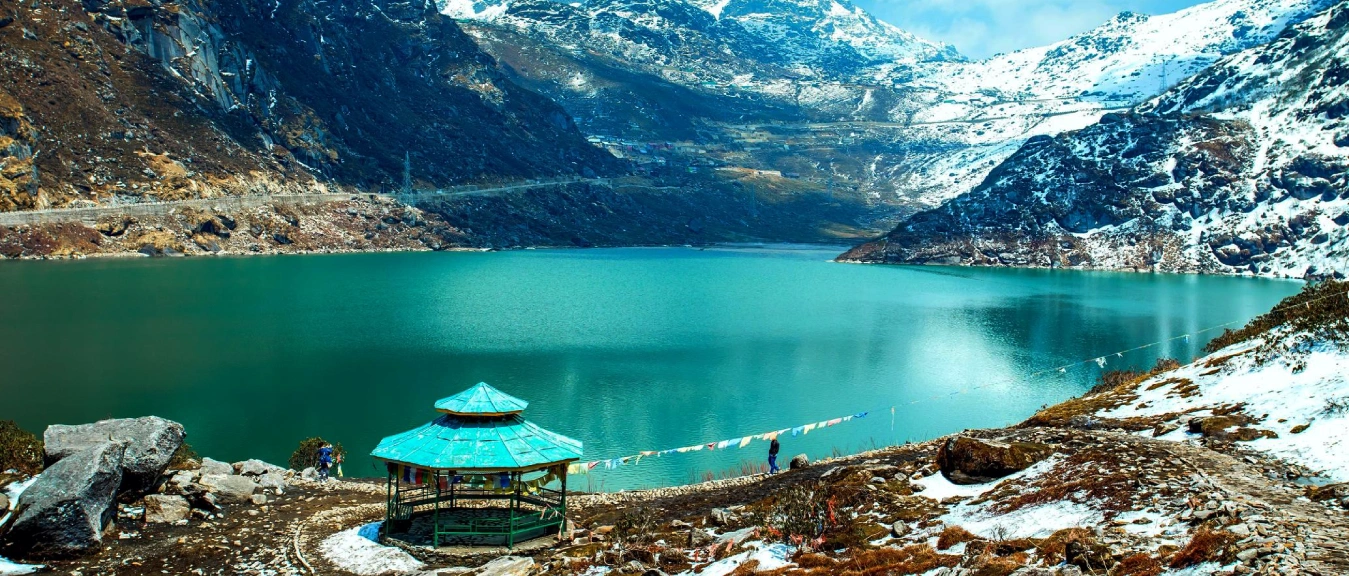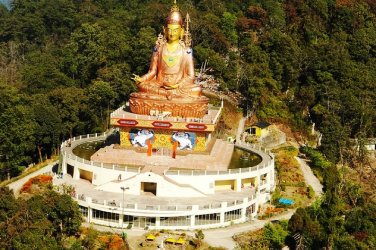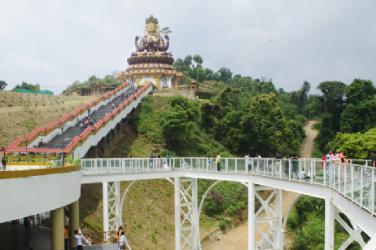





| Area | 7096 Sq. Kms. |
| District | 6 |
| Sub-division | 16 |
| Total Forest Cover | 47.34% |
| State Animal |
Red Panda |
| State Bird | Blood Pheasant |
| State Flower | Dendrobium Nobile (Nobile Orchid) |
| State Tree | Rhododendron Niveum |
| Population | 6,10,577 |
| Density of Population | 86 Persons per Sq. Km. |
| Literacy Rate | 81.4% |

Sikkim, state in India,is located in the northeastern part of the country, in the eastern Himalayas. It is one of the smallest states in India. Sikkim is bordered by the Tibet Autonomous Region of China to the north and northeast, by Bhutan to the southeast, by the Indian state of West Bengal to the south, and by Nepal to the west. The capital is Gangtok, in the southeastern part of the state
A part of the Eastern Himalaya, Sikkim is notable for its biodiversity, including alpine and subtropical climates, as well as being a host to Kangchenjunga, the highest peak in India and third highest on Earth. Sikkim's capital and largest city is Gangtok. Almost 35% of the state is covered by the Khangchendzonga National Park.
Long a sovereign political entity, Sikkim became a protectorate of India in 1950 and an Indian state in 1975. Its small size notwithstanding, Sikkim is of great political and strategic importance for India because of its location along several international boundaries. Area 2,740 square miles (7,096 square km). Pop. (2011) 607,688.
Sikkim has six districts namely Gangtok, Mangan, Namchi, Gyalshing, Pakyong and Soreng. The district capitals are also Gangtok, Mangan, Namchi, Gyalshing, Pakyong and Soreng respectively. These six districts are further divided into 16 subdivisions. Pakyong and Soreng Districts were added after December 2021.
The Sikkim National Transport Bus and other four wheeler taxi serve the means of transport in the East District and connectivity to other district and neighbouring state like West Bengal. Gangtok is connected by road with Darjeeling, Kalimpong, Siliguri and also with all the district head quarters.
The nearest and only airport is Pakyong Airport at Pakyong District of Sikkim which is around 32 km from Gangtok. From there one can hire a taxi or bus service to come up to Gangtok. Another airport at Bagdogra (West Bengal). The distance from Bagdogra to Gangtok is 124.5 km and it takes approximately 4 hours to reach Gangtok. Helicopter/ Chopper services are also available from Bagdogra to Gangtok.
The nearest railway station to Gangtok are Siliguri (113 km) and New Jalpaiguri (125 km) connecting Kolkata, Delhi and other important cites of the country. Rail connectivity is under construction between Rangpo in Sikkim to Siliguri in West Bengal, which is estimated to be completed by the end of 2025.
From Bagdogra Airport and New Jalpaiguri or Siliguri railway stations one can hire a taxi Siliguri bus stand. From there, one has the option to travel to Gangtok by Sikkim Nationalised Transport Buses run by Government of Sikkim which takes roughly a 5-6 hour journey. Luxury taxis/normal taxis also which can be booked at the airport or railway stations or by tour and travel operators.
Extremely alluring, pleasantly boisterous and wreathed in clouds - Gangtok, the capital city of the Sikkim can also give you a spectacular view of Mt. Kanchenjunga, at a distant skyline. The pristine hill station nestled in mountains and clouds is also a base for a whole lot of trekkers to the Himalayan mountain ranges. The mesmerizing prismatic beauty and the beautiful winding hill roads are even more breathtaking if seen from a bird’s eye view in a cable car.
The name meaning hill-top, Gangtok can be safely said to be one of the most beautiful hill stations in the country. With everything in just the right amount from a blend of cultural identities to urbanization, Gangtok is a breathing and dynamic bit of paradise of the northeast. It has an amazing view of mount Kanchenjunga, the third highest mountain peak in the world. Also like everything around it, Gangtok is abundant in natural beauty and has various natural attractions such as the Tsomgo Lake, Ban Jhakri falls, Tashi viewpoint and more. Other places to visit include the Enchey Monastery, Ganesh Tok, Do Drul Chorten Rumtek Monastery, etc. Also, river Teesta is one of the best spots for white water rafting in North East India.
Gangtok experiences pleasant weather during the summer season. The temperature hovers 18°C to 25°C during the season. It is the best time to visit Gangtok if you would like to escape the heat. The blend of warm sunshine and cool breeze promises every visitor with an unforgettable vacation of indulging in amazing things to do with your family and friends. Honeymoon couples planning a trip to Gangtok are certainly in for a treat as it offers absolutely delightful weather.
One of the most important and magnificent places to visit in Gangtok, the Tsomgo Changu Lake is a glacial lake situated 40 kilometres from Gangtok at a height of 12,310 feet. A fairytale lake of breathtaking beauty, Tsomgo Changu should definitely be on your travel itinerary for Gangtok. The icy blue waters of the lake reflecting the grandiose peaks of the Himalayas make for a spectacular sight. The prayer wheels and the small Shiva temple on its shores are a testimony to the sacred nature of the lake in the eyes of the locals.


One of the most significant places to visit in Gangtok, the Nathu La Pass is a pass which connects Sikkim with China's Tibet Autonomous Region. In the ancient days, this pass formed a part of the Silk Route, one of the most important trading routes in the world. Visiting Nathu La Pass is a must-do when in Gangtok because the views and experiences that you can have here are unlike any other. The beautiful pass can simply be enjoyed by driving or hiking around it leisurely. The height of the pass ensures magnificent mountain views, especially on clear days.
A temple dedicated to the memory of Harbhajan Singh, a soldier martyred during the Sino war. Harbhajan Singh died defending his country and fellow soldiers on the Nathu La pass. His legend is also believed to have supernatural powers and his ghost is believed to guard soldiers along the border. This belief has led to the Indian army treating him as a soldier who never died.
Harbhajan Singh continued to receive his rank duly till he “retired” some years ago. This legend is the reason this temple is so popular with tourists in Gangtok. A visit to this temple is an enjoyable experience and can be combined with a visit to Nathu La pass. You must book a tour of Gangtok which includes Baba Harbhajan Singh Memorial Temple.

Local sight-seeing in and around Gangtok:
Believed to be a sacred lake for Buddhists and Hindus, Gurudongmar Lake is one of the most popular tourist places in North Sikkim. Located at an altitude of 17,800 feet, the breathtaking beauty of this lake will leave you in awe of the surroundings.
Places of Interest in North Sikkim
Located at the height of 17,100 feet above the sea level, Gurudongmar Lake, located in Sikkim, is one of the fifteen highest lakes in the world. It is also the second highest lake in Sikkim, after the Cholamu Lake located at the height of 18,000 feet.


The popular Yumthang Valley in North Sikkim is located 140 km north of Gangtok. Famous as the "Valley of flowers", this is a rare and exotic location with hot springs, rivers, yaks and lush green meadows. Situated at an elevation on 3564 metres, this stunning valley is a paradise for nature lovers as it houses the Shingba Rhododendron Sanctuary which has over 24 species of Rhododendron flowers (the state flower) blooming from late February to mid-June.
Situated in the northern district of Sikkim, Lachen and Lachung is one of the most beautiful towns an attractive tourist spot. Lachung is also well known for its Lachung monastery. Its natural beauty and serene vegetation are worth commending and it is believed to be one of the most noteworthy and popular places for Buddhist pilgrims and tourists. Lachen and Lachung is a less-populated beautiful holiday destination


Nestled in the northern part of Sikkim at a distance of 144 km from Gangtok and 28 km from Lachung, Mount Katao is one of the most stunning sights imaginable. Perfect for adventure lovers.
Kalapatthar is a famous tourist destination in North Sikkim, India, known for its breathtaking views of the snow clad mountains and mesmerizing landscapes.

Namchi, the district headquarters of the South District, is a prosperous market town which has quickly developed into a tourist hotspot. Namchi literally means "Top of the Sky" and the main tourist attractions of Namchi are the two gigantic statues. These two gigantic statues are facing off from opposite hillsides across Namchi and attract several tourists every year. Set in a scenic environment, Namchi provides you a beautiful view of the Khangchendzonga range and the Rangit valley. Namchi is quickly transforming into a tourist hotspot because of its pilgrimage centres. The world 's largest statue is also situated here and is worth seeing.
Top Attraction
Solophok is known as the pilgrimage centre in South Sikkim. Situated some 5kms from Namchi, Solophok has a main temple of 108 feet height on which is based the 87 feet high statue of Lord Shiva in the sitting posture. Apart from Shiva statue, Solophok also has replicas of the twelve Jyotirlingas making it a must-visit place for Shiva devotees. The complex covers an area of approximately 7 acres and is accessible by a smooth road.


This giant statue of Guru Rinpoche is located in Namchi and is 118 ft. in height. Guru Rinpoche's actual name was Guru Padmasambhava and is also known as Second Buddha. He is said to have transmitted Vajrayana Buddhism to Tibet, Bhutan and surrounding area in the 8th century AD. He is also considered to be the emanation of Buddha Amitaha, Shakyamuni Buddha and Kuan Yin Bodhisattva.
Tathagata Tsal, or better known as the Buddha Park of Ravangla is a beautiful park situated in the Ravangla (Rabong) in South Sikkim. The main highlight of the park is the magnificent statue of Buddha installed as a centrepiece with a height of 130-foot (40 m). It was constructed between 2006 and 2013, statue of the Buddha, erected to mark the 2550th anniversary of the birth of Gautama Buddha, as its main attraction. The statue, built of 60 tonnes of copper, is an example of excellent work.


The Temi Tea Garden in Temi, South Sikkim established in 1969 by the Government of Sikkim, is located in Namchi in the northeastern Indian state of Sikkim. It is the only tea garden in Sikkim and is considered one of the best in India and the world. Top quality tea is produced, which is in demand in the international market. The garden is laid over a gradually sloping hill. The tea produced in this garden is also partly marketed under the trade name "Temi Tea". This tea garden is very attractive and mesmerizing for taking pictures.
Gyalshing District or Geyzing District is a district of the Indian state of Sikkim. Its headquarter is Geyzing, also known as Gyalshing. The district is a favourite with trekkers due to the high elevations. Other important towns include Pelling and Yuksom
The Chenrezig statue and skywalk are a tourist attraction in Pelling, West Sikkim district, Sikkim. The complex houses a 137 ft (42 m) tall statue of the bodhisattva Chenrezig, the tallest Chenrezig statue in the world. The place is also the location of India's first glass skywalk. The site was inaugurated in 2018 and has since attracted significant footfall. The glass-bottomed skywalk overlooks the Chenrezig statue and the flight of stairs leading up to it. There are golden prayer wheels on both sides of the stairs. The foundation stone of the Chenrezig statue was laid in 2009 and consecrated by the Dalai Lama.


Rabdentse was the second capital of the former Kingdom of Sikkim from 1670 to 1814. The capital city was destroyed by the invading Gurkha army and only the ruins of the palace and the chortens are seen here now. However, the ruins of this city are seen close to Pelling and in West Sikkim district in the Northeastern Indian state of present-day Sikkim; Pemayangtse Monastery is one of the oldest monasteries in Sikkim which is close to the ruins. The Rabdentse Ruins are the ruins of a palace and monastery complex located near Pelling. The ruins offer a glimpse into the rich history of the region and are surrounded by stunning natural beauty.
Khecheopalri Lake, originally known as Kha-Chot-Palri (meaning the heaven of Padmasambhava), is a lake located near Khecheopalri village, 147 kilometres (91 mi) west of Gangtok in the West Sikkim district of the Northeastern Indian state of Sikkim. The formation of the lake is estimated to be 3500 years old. Khecheopalri Lake is a sacred lake located near Pelling. The lake is believed to be a wish-fulfilling lake and is a popular pilgrimage site for Buddhists. Visitors can also enjoy the scenic beauty of the lake and surrounding forest.


The Barsey Sanctuary can be reached from three points, Hilley, Dentam and Soreng, Filled with an undulating path shaded by different species of rhododendron. Sikkim government has an arrangement for tourists to stay on top of the hill in a forest barrack. There are now several home-stays at the entrance of Versay Rhododendron Sanctuary as well as at Okhrey which is a small village inhabited by mainly the Sherpa Community. The Hilley gate is most popular since the trek distance from here is only 4-5 kms taking around two hours one way. It is a well marked forest trail and can be easily traversed without a guide. One can also experience a multiple day trek inside this forest but that will require a proper guide and camping equipment. Trek to Barsey Rhododendron Sanctuary is around 4 KM with not much steep road. So one way journey would take you around 2 Hours depending on your walking ability. But rest assured, it's one of the easiest trek in the earth which is also known as Honeymoon Trek.